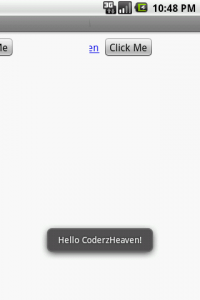Hello everyone
Today I will explain how will you call a function that is defined inside the java android code from a webview.
For this we need to add a webviewclient in android for the WebView we are adding in the xml.
Then we have to register the webviewclient with the WebView we are creating using this method.
myWebView.setWebViewClient(new MyWebViewClient());
Now we will start….
Create a new project and name it WebViewDemo.
Now in the main.xml copy this code.
This file contains the webview only.
<?xml version="1.0" encoding="utf-8"?>
<WebView xmlns:android="http://schemas.android.com/apk/res/android"
android:id="@+id/webview"
android:layout_width="fill_parent"
android:layout_height="fill_parent"
/>
Now create a file named test.html inside the assets folder and copy this code into it. This is the html file that we are loading into the webview.
<?xml version="1.0" encoding="UTF-8"?>
<!DOCTYPE html PUBLIC "-//W3C//DTD XHTML Basic 1.1//EN"
"http://www.w3.org/TR/xhtml-basic/xhtml-basic11.dtd">
<html>
<body>
<a href="http://www.coderzheaven.com">CoderzHeaven</a>
<input type="button" value="Click Me" onClick="showAndroidToast('Hello CoderzHeaven!')" />
<script type="text/javascript">
function showAndroidToast(toast) {
Android.showToast(toast);
}
</script>
</body>
</html>
Now in the java code refer the webview and load the html file
WebView myWebView;
myWebView = (WebView) findViewById(R.id.webview);
myWebView.loadUrl("file:///android_asset/test.html");
Now enable the javascript by calling this function
WebSettings webSettings = myWebView.getSettings(); webSettings.setJavaScriptEnabled(true);
Now we have to add the javascript interface for listening to the javascript functions that we define in the webview html file.
myWebView.addJavascriptInterface(new JavaScriptInterface(this), "Android");
// outside oncreate
public class JavaScriptInterface {
Context mContext;
/** Instantiate the interface and set the context */
JavaScriptInterface(Context c) {
mContext = c;
}
/** Show a toast from the web page */
public void showToast(String toast) {
Toast.makeText(mContext, toast, Toast.LENGTH_SHORT).show();
startActivity(new Intent(WebViewDemo.this, WebViewDemo.class));
}
}
Now create a webview client for listening to the browser activities and doing specific function.
myWebView.setWebViewClient(new MyWebViewClient());
private class MyWebViewClient extends WebViewClient {
@Override
public boolean shouldOverrideUrlLoading(WebView view, String url) {
if (Uri.parse(url).getHost().equals("www.coderzheaven.com")) {
Toast.makeText(getApplicationContext(), "www.coderzheaven.com", Toast.LENGTH_SHORT).show();
return false;
}
// Otherwise, the link is not for a page on my site, so launch another Activity that handles URLs
Intent intent = new Intent(Intent.ACTION_VIEW, Uri.parse(url));
startActivity(intent);
return true;
}
}
Now we listen to the backbutton.
@Override
public boolean onKeyDown(int keyCode, KeyEvent event) {
// Check if the key event was the BACK key and if there's history
if ((keyCode == KeyEvent.KEYCODE_BACK) && myWebView.canGoBack()) {
myWebView.goBack();
return true;
}
return super.onKeyDown(keyCode, event);
}
Now the project is over . Now run and see the result.
Here is the full java code for this example
package com.coderzheaven.pack;
import android.app.Activity;
import android.content.Context;
import android.content.Intent;
import android.net.Uri;
import android.os.Bundle;
import android.view.KeyEvent;
import android.webkit.WebSettings;
import android.webkit.WebView;
import android.webkit.WebViewClient;
import android.widget.Toast;
public class WebViewDemo extends Activity {
WebView myWebView;
@Override
public void onCreate(Bundle savedInstanceState) {
super.onCreate(savedInstanceState);
setContentView(R.layout.main);
myWebView = (WebView) findViewById(R.id.webview);
myWebView.loadUrl("file:///android_asset/test.html");
WebSettings webSettings = myWebView.getSettings();
webSettings.setJavaScriptEnabled(true);
myWebView.addJavascriptInterface(new JavaScriptInterface(this), "Android");
// myWebView.setWebViewClient(new WebViewClient());
myWebView.setWebViewClient(new MyWebViewClient());
}
public class JavaScriptInterface {
Context mContext;
/** Instantiate the interface and set the context */
JavaScriptInterface(Context c) {
mContext = c;
}
/** Show a toast from the web page */
public void showToast(String toast) {
Toast.makeText(mContext, toast, Toast.LENGTH_SHORT).show();
startActivity(new Intent(WebViewDemo.this, WebViewDemo.class));
}
}
private class MyWebViewClient extends WebViewClient {
@Override
public boolean shouldOverrideUrlLoading(WebView view, String url) {
if (Uri.parse(url).getHost().equals("www.google.com")) {
// This is my web site, so do not override; let my WebView load the page
Toast.makeText(getApplicationContext(), "www.google.com", Toast.LENGTH_SHORT).show();
return false;
}
// Otherwise, the link is not for a page on my site, so launch another Activity that handles URLs
Intent intent = new Intent(Intent.ACTION_VIEW, Uri.parse(url));
startActivity(intent);
return true;
}
}
@Override
public boolean onKeyDown(int keyCode, KeyEvent event) {
// Check if the key event was the BACK key and if there's history
if ((keyCode == KeyEvent.KEYCODE_BACK) && myWebView.canGoBack()) {
myWebView.goBack();
return true;
}
// If it wasn't the BACK key or there's no web page history, bubble up to the default
// system behavior (probably exit the activity)
return super.onKeyDown(keyCode, event);
}
}
please leave your valuable comments if this post was useful.

Awesome tutorial, just what I was looking for. Cheers!